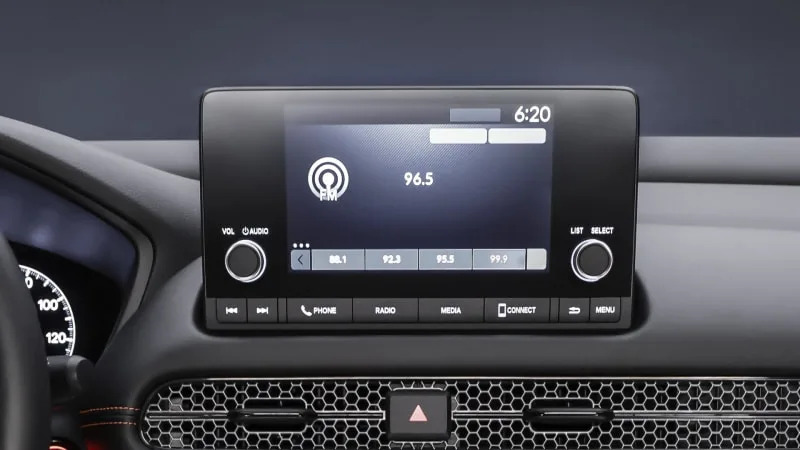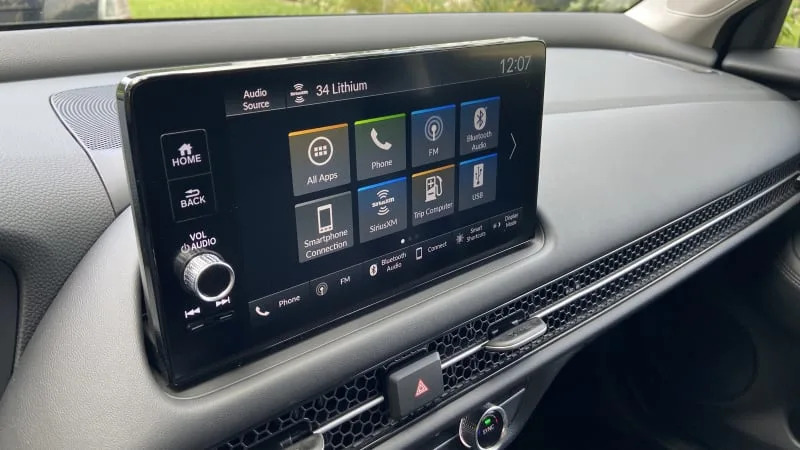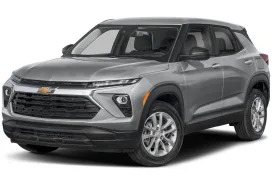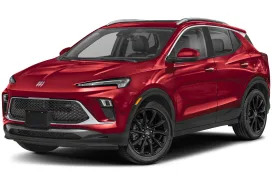Pros: High-end cabin; it’s basically a big Civic; top safety scores; Honda dependability and resale
Cons: Slow for the segment without a fuel economy bonus; bare bones base infotainment; so-so cargo area; no sporty or outdoorsy trim levels
Opting for the 2025 Honda HR-V is a very sensible choice. It has top safety scores, loads of space, a well-made cabin, sold feature content for the money and carries Honda’s well-earned reputation for reliability and resale value. As simple, dependable transportation for those wanting to sit up a bit higher and needing some extra versatility, the HR-V checks the boxes. Perhaps it’s not surprising that the HR-V is so popular with first-time and Gen Z car buyers who, no doubt, want to make sure their first go at this car thing doesn’t go awry.
As they may eventually find out, however, there’s more to a car purchase than checking boxes. While the HR-V is certainly sensible, it is also incredibly dull. Competitor subcompact SUVs offer distinctive style, better performance, more enjoyable driving experiences and can cater to certain niches with sporty or off-road variants. Importantly, those rivals are plenty sensible in their own right, with interior volumes, fuel economy and/or prices that better the HR-V.
Which rivals? Well, the list is awfully long (Chevrolet Trax, Buick Envista, Kia Seltos, Subaru Crosstrek, Kia Niro hybrid, Hyundai Kona, Volkswagen Taos, Mazda CX-30), which speaks to just how low on the pecking order we place the HR-V. So, by all means check out Honda’s small SUV, but know you can find something that checks boxes and pulls on heart strings just as well.
Interior & Technology | Passenger & Cargo Space | Performance & Fuel Economy
What it's like to drive | Pricing & Trim Levels | Crash Ratings & Safety Features
What's new for 2025?
Once again the HR-V carries over unchanged, albeit with a roughly $1,000 price increase.



What are the HR-V interior and in-car technology like?
Apart from its unique high-mounted “floating” center console, the HR-V’s handsome design and above-average materials are largely in keeping with the Honda Civic. That’s a great thing. The most obvious Civic cue is the wheel-to-door air vent plated by a metal-look honeycomb pattern. There may come a day when Honda overuses this design element but, for now, it’s exceptional. You can read our deep dive review of the HR-V EX-L interior here, and see what the mid-grade Sport looks like above with its distinctive, almost plaid-like fabric upholstery.
The touchscreen interfaces differ in size (7 inches in LX and Sport, 9 inches in EX-L) as well as user interface, with the bigger one possessing more features and colorful graphics. Now, are those screens better than those of the HR-V’s rivals? The bare-bones small screen is definitely worse, and when compared to the Kia Seltos and Chevy Trax/Buick Envista twins, the 9-inch one is unlikely to be preferred as well. It’s not demonstrably worse, though, and seems unlikely to be a dealbreaker.
Three USB-A ports also reside in the center console, and the range-topping EX-L trim level gets wireless charging to go with wireless Apple CarPlay and Android Auto capability. Wired versions come standard.


How big is the HR-V?
The current HR-V grew to meet the bigger subcompact SUV standard now met by everything else in the segment. Passenger space is among the best in the group, and along with the Taos, Trax and Envista, is one of the more family friendly as a result.
In terms of cargo space, there is 24.4 cubic feet of cargo space. That’s only mid-pack, with the Seltos, Taos and Bronco Sport having more. More importantly, we found the HR-V's angled liftgate opening makes it difficult to load luggage inside and reduces functionality compared to not only those more-voluminous-on-paper competitors, but others like the Buick Envista and Subaru Crosstrek. The HR-V does at least boast a back seat that folds totally flat thanks to a smartly engineered, multi-hinged seat bottom that dips down into the footwell. No dual-level cargo floor necessary.


What are the HR-V fuel economy and performance specs?
There is only one engine and transmission combo available: a 2.0-liter inline-four good for 158 horsepower and 138 pound-feet of torque that’s connected to a continuously variable transmission. Front- and all-wheel drive are available. Its output is below average for the segment – many of which offer even more powerful upgrades.
EPA-estimated fuel economy comes in at 26 mpg city, 32 mpg highway and 28 mpg combined with front-wheel drive. It falls to 25/30/27 with all-wheel drive. This is actually lower than those more powerful rivals.

What's the HR-V like to drive?
It’s quite slow, with a dearth of low-end grunt (its piddling 138 pound-feet of torque arrives at a lofty 4,200 rpm). Lay into the throttle and nothing really happens, which is in contrast to the punchy little turbo engines of many competitors. That’s includes the Chevy Trax and Buick Envista, which have similar on-paper 0-60 times as the HR-V, but ultimately feel much quicker. The HR-V is slow and it feels slow. The CVT does a good job of behaving like a reasonably normal transmission by simulating gears, and even applying engine braking when going downhill when in Sport or Low modes. Should you want to hustle things along, the Sport mode doesn’t really live up to its billing, as it’s too eager to upshift. There are no paddle shifters available.
Beyond the powertrain, the driving experience is impressively refined for the segment. Perhaps it’s the various previous-generation CR-V bits and pieces in the suspension, but it does have a more substantial, sophisticated feel. Body roll is kept in decent check and the steering is consistently weighted with commendable response. The ratio is noticeably slower than the Civic’s, though, and working through a winding mountain road required more turning angle than expected. This is in contrast to the more lively, engaging Mazda CX-30 and Chevy Trax. There’s definitely a sportier version possible here should Honda choose to go there – ditto one better suited to outdoorsy activities, such as a TrailSport version. The HR-V’s ground clearance is modest at only 7 inches, and there are no roof rails, either.
What other Honda HR-V reviews can I read?
2023 Honda HR-V First Drive
A deeper dive into how the new HR-V differs from its predecessor, plus insights on why those changes were made (and why there's no turbocharged engine).

Honda HR-V Luggage Test
The HR-V underwhelms when it comes to hauling stuff, especially compared to its ultra-versatile predecessor.

Honda HR-V EX-L Interior Review
Taking a deep dive into the top-of-the-line EX-L interior, including its materials quality, storage, technology and space.

Honda HR-V vs Toyota Corolla Cross: Which is better?
We take a look at two of the best-sellers in the segment, comparing specs and our separate impressions of them. Ultimately, though, we recommend folks look beyond these two.

What is the 2025 HR-V price?
Pricing starts at $26,450 for the base, front-wheel-drive LX trim level. That includes the $1,350 destination charge. That starting point, plus those of upper trim levels, are competitive with most rivals, including the Kia Seltos and Subaru Crosstrek. However, as we’ve stated above, the HR-V has notable demerits or at least comes up short. It’s also important to call out the Chevy Trax and Buick Envista, which cost considerably less.
Unlike some of those rivals, there are no special trim levels to call out that offer sportier looks or driving dynamics, or off-road-themed versions that gain extra ground clearance and functionality for carrying outdoor adventure gear. The HR-V Sport comes close, but it’s really just the mid-grade trim with some sporty-ish touches like black wheels outside and amber stitching inside.
All prices below include the $1,350 destination charge. All are also optional with all-wheel drive, which adds $1,500 to the price.
LX: $26,450
Sport: $28,550
EX-L: $30,550
What are the HR-V safety ratings and driver assistance features?
Every 2025 HR-V includes as standard equipment forward collision warning, automatic emergency braking, lane-departure warning, lane-keeping assist, and adaptive cruise control with stop-and-go capability and lane-centering steering assist. It also includes rear side airbags, which is rare. Blind-spot and rear cross-traffic warning are included on the Sport and EX-L.
The NHTSA gave the HR-V five-out-of-five stars for overall, frontal and side crash protection. The Insurance Institute for Highway Safety named it a Top Safety Pick+ for its best-possible performance in all crash protection and prevention categories plus a sufficiently high headlight rating.













Sign in to post
Please sign in to leave a comment.
Continue